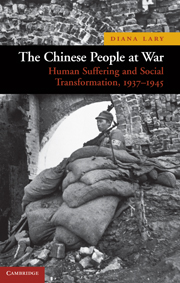Book contents
- Frontmatter
- Contents
- List of Illustrations
- List of Maps
- Preface
- Introduction: The Human Cost of War
- 1 The High Tide of War: July–December 1937
- 2 Defeat and Retreat: 1938
- 3 Stalemate and Transformation: 1939–1941
- 4 Grim Years: 1942–1944
- 5 Turning Points: 1944–1945
- 6 The Immediate Aftermath of the War: 1945–1946
- 7 The Legacy of the War
- Final Words
- Glossary
- Index
- References
1 - The High Tide of War: July–December 1937
Published online by Cambridge University Press: 05 June 2012
- Frontmatter
- Contents
- List of Illustrations
- List of Maps
- Preface
- Introduction: The Human Cost of War
- 1 The High Tide of War: July–December 1937
- 2 Defeat and Retreat: 1938
- 3 Stalemate and Transformation: 1939–1941
- 4 Grim Years: 1942–1944
- 5 Turning Points: 1944–1945
- 6 The Immediate Aftermath of the War: 1945–1946
- 7 The Legacy of the War
- Final Words
- Glossary
- Index
- References
Summary
The Prelude to War
In the late 1920s and early 1930s, China seemed to be entering a new era of unity and change. The Guomindang (GMD) established a new central government for China in 1928 and moved the national capital from Beijing (Northern Capital) to Nanjing (Southern Capital). Beijing was renamed Beiping (Northern Peace).
At its inception, the government controlled only a few provinces of central China; it grew stronger over the next few years, Chiang Kai-shek's (Jiang Jieshi) government gradually brought several of the major regional warlords (Feng Yuxiang, Yan Xishan, and the Guangxi Clique) under some degree of control. The Young Marshall of Manchuria, Zhang Xueliang, was critically weakened when Manchuria was occupied by Japan in 1931. In 1934, government forces evicted the Chinese Communist Party (CCP) from its remote base in Jiangxi and forced it to undertake the epic Long March. The march brought the party and its armies to a remote base in Yan'an (Shaanxi), where the communists could recuperate from the terrible hardships they had suffered along the way, sufferings that became the stuff of the CCP's vision of its triumph through adversity. In 1937, however, the CCP was still a tiny, battered rump of survivors, far from the centres of Chinese life.
In the great cities of eastern China, the early 1930s were a time of growth, and excitement in business, literature, education, music, and popular culture put together constituted the rapid arrival of modernity.
- Type
- Chapter
- Information
- The Chinese People at WarHuman Suffering and Social Transformation, 1937–1945, pp. 15 - 43Publisher: Cambridge University PressPrint publication year: 2010



